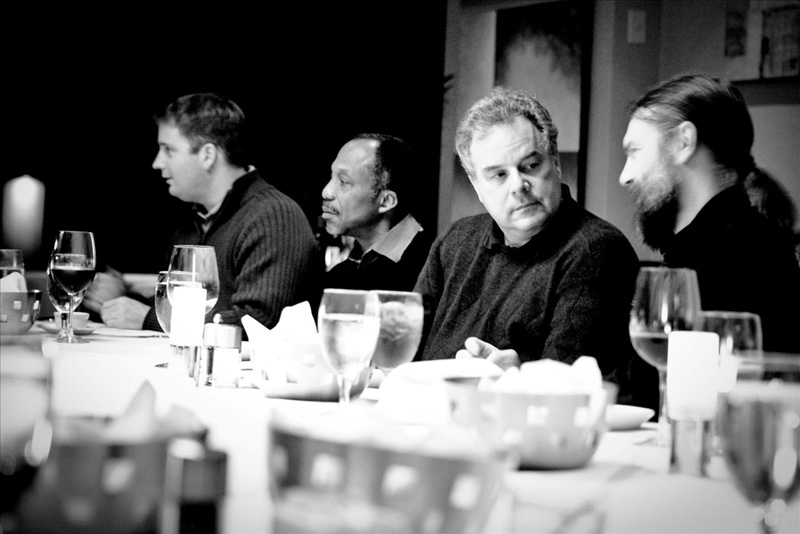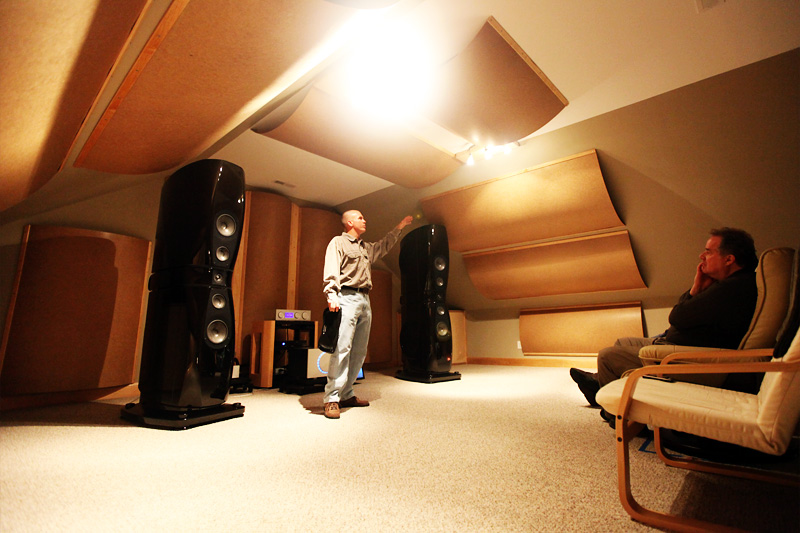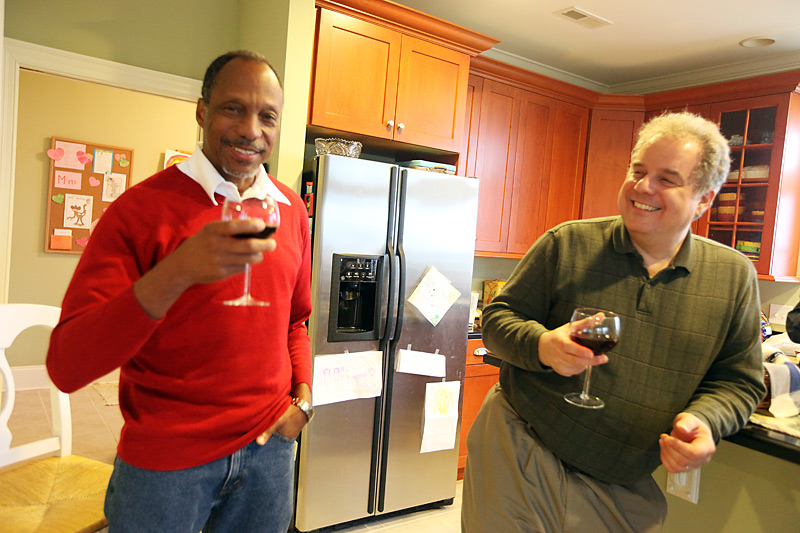| April 1, 2009
Concerto for Writer and The World’s Best Audio
System 2009
Somewhere in the sky over the Midwest, the question came to
me: Why am I flying halfway across the country to listen to a stereo system?
The answer, which I shared with the group attending TWBAS
2009 at dinner Friday night, came out something like this:
Back when I was a teenager, I had a "profound"
philosophical discussion with some friends about which physical sense would be the most
disabling to lose. Everyone else agreed that it would be impossible to get around in the
world without eyes. I thought that the hardest thing would be to give up my ears. Ears
open up the world of music, the splash of a fish in a lake, the call of a loon at
twilight, and the human voice, with all its expressions of meaning and emotion -- how
could I live without those?
And so I was flying over 1000 miles -- on my own dime -- to
listen to the top-rated and outrageously expensive audio gear that Jeff Fritz had
assembled in his home in Hampstead, North Carolina, for The World’s Best Audio System
2009 event on March 13-14.
Jeff also offered me the opportunity to write about the
experience, which resulted in near-simultaneous responses of Yes! and Omigod!
-- the sort of reaction I have when I get a chance to do something I really, really want
to do, and can’t quite imagine how I’ll go about doing it.
The problem was evident. How on earth could I ever say
anything meaningful about the experience of listening to this system? It wasn’t as
though I could cheerfully remember and compare it with all the other $360,000 systems I
regularly hear -- I’ve never heard any at all (excepting, possibly, Ray Kimber’s
setup at the 2007 Rocky Mountain Audio Fest, which was in a room that was far from ideal).
Given the stellar creds of the manufacturers and the astronomical prices of the gear, it
seemed that the only possible response to the actual sound of TWBAS might be something on
the order of Wow!, the only variation being the number of exclamation points
following the word.
Compared to other world issues, I suppose that’s not
such a bad problem to have. But given that I at least wanted to make a sincere effort to
solve it, I decided to go a different route. The assumption is that such exalted audio
gear will present music as it "should" be presented -- which would be, most
would agree, as close to the original performance as possible. So to calibrate my ears and
brain to the real thing, I decided to spend the last few weeks before the event soaking
myself in as many live musical performances as I could.
An unexpectedly busy work schedule meant that I failed in
this almost entirely. But I did listen to some live piano and vocal performances at nearby
Lawrence University. I made sure a trip to Washington, DC, included a visit to Blues
Alley, where saxophonist Kim Waters was holding forth in great style. Beyond that, I had
to rely on my deeply ingrained memory of live acoustic instruments dating back to
childhood. Still, I was about as prepared as I could be for what I’d hear.
Or so I thought.
1. Nocturne de l’amour (et du mauvais bruit)
Shouldn’t every significant musical event begin with
great food and companionship? Doug Schneider and Jeff Fritz (and Jeff’s wife, Andrea,
who did an amazing job entertaining our palates throughout the weekend) had arranged to
have a wonderful welcoming dinner on Friday evening for the attendees at our hotel’s
top-rated steak restaurant.
Good as the food was, the conversation was better.
Sandwiched between fellow Ultra Audio contributor Simeon Sandiford (all the way
from Trinidad) and a very tired Ralf Ballmann of Behold, who had been in transit from
Germany for over 16 hours, I had a conversation about what we all most care about and
love. We talked about our families, our work, audio concepts and technology, and
challenges such as the task of introducing young people to high-end audio.

Albert Bellg (second from right) at the TWBAS 2009
dinner (see the entire "TWBAS 2009: Dinner" gallery).
The creators of the gear in TWBAS 2009 (or their
representatives) were all present, and there was a friendly camaraderie and palpable
anticipation about what we’d soon be hearing. Between the conversation and the food
and the wine, we were a happy crowd by the time the meal ended at nearly 11:00 p.m. We
were tired, too, so only a few of us (Ron Lapporte from Blue Smoke, Simeon, Doug, and me)
took up Jeff on his offer to drive to his house for a preliminary listen to the audio
system, with the promise that we’d be on our way home by 12:30.
That first look at the system -- and at Jeff’s
acoustically excellent Music Vault -- was impressive. It was a bit like entering a room
full of football players: everything was larger and more imposing than one might have
imagined. Yet it was simple, too. Not a lot of clutter and excess, just the basic tools to
do the job of being The World’s Best Audio System.
At the top of the list of impressive gear were the Arrakis
loudspeakers ($165,000 USD per pair), from Andrew Payor’s Rockport Technologies. Well
over 6’ tall, they loomed over us without seeming overwhelming. Their elegantly
glossy transparent finish over a black carbon-fiber matte minimized any sense that they
were dominating the room. The Behold BPA768 analog amplifier with internal DAC ($50,000)
was front and center, a large silver cube with a glowing blue circle on the front.
Behold’s fully digital APU768 preamplifier with room-correction circuitry ($58,000)
was on top of the rack, its rectangular blue screen prominently indicating the level of
signal attenuation. Right below it was the relatively small and modest Black Box music
server from Blue Smoke Entertainment Systems ($6995), which did the honors of compiling
and playing back our music. Next to it, down on the floor, was its touchscreen controller
(there was a remote keyboard controller as well); an Ethernet cable linked it to a network
storage system in another room.
Shunyata Research provided its King Cobra and Anaconda
power cables, Guardian Pro and Hydra V-Ray II power conditioners, and Dark Field Cable
Elevators ($21,485 total). Gabi van der Kley, of The Netherlands’ Crystal Cable, had
sent over her Dreamline speaker cables ($18,750/3m pair) and digital cable ($10,250 per 4m
cable), and had flown in herself to listen to the system. Finally, Michael Latvis of
Harmonic Resolution Systems provided state-of-the-art vibration control and isolation with
a MXR-1921-3V audio stand and a host of isolation bases and smaller stands ($28,715
total). For those who want to race out and buy the entire system, the bill would come to
$360,679.
After a fair amount of admiring and poking around, we
finally sat down to listen. Jeff had selected seven short musical samples designed to give
us a broad taste of the system. We listened, then talked a little, then listened some
more. The system sounded extraordinarily transparent and coherent, and the bass was very
clean, and more effortlessly extended than any other system I’d heard. But if I were
reviewing a component that made my own system sound as TWBAS 2009 initially did, I’d
be having a problem with it. There was an alarming glare in the upper midrange that was
not nearly of the musical quality I’d expected to hear. It was not subtle, as
reviewers sometimes say, and there was general concern and agreement that it should be
addressed.
There was also agreement that, at 12:45 a.m., not much of
what needed to happen would occur that night. As we exited the Music Vault, Simeon made a
modest suggestion: "Leave it on all night. Let it run."

Jeff Fritz explains the TWBAS 2009 setup.
2. Danse de changement
Maybe I was taking all this too personally, but it was a
restless night for me, full of speculation. I did not want to write about the
system as I had heard it. What was wrong? It probably wasn’t the speakers or the
cables, I thought, and probably not the amp’s analog circuits. Maybe the
digital processor? Or something else in the circuit? If it were my own system, what would
I do? Endless questions and no answers. Just before morning, I finally got a few
hours’ sleep.
We arrived back at TWBAS 2009 around 11:30 a.m. after
getting lost along the way -- which probably was a good thing, as it gave Jeff, Ralf,
Andy, and the team from Blue Smoke more time to work on the system. Significant progress
was made, and much to the relief of my ears, the system sounded as if it was beginning to
reach its potential. Between letting it run all night and turning off the room correction,
two-thirds of last night’s upper-midrange glare was gone. Still, it wasn’t as
good as it should have been.
Then Mike Latvis of Harmonic Resolution Systems, who’d
been sitting quietly for awhile listening to the system, said, "I think I need to
switch around the platforms." Turns out the 90-pound Behold amplifier was sitting on
a resonance-control platform rated for 30 pounds, and had bottomed out. Furthermore, the
lightweight Blue Smoke server was on a platform designed for heavier loads, so that
platform wasn’t controlling resonances properly, either. Swapping platforms and
placing them under the gear they were designed for resulted in greater clarity to the
sound, and widened and deepened the soundstage.
Using the new upsampling hardware on the Blue Smoke front
end was a further improvement, and when Grant Samuelson added some Shunyata Dark Field
cable lifters to the speaker cables and cable separators to the interconnects, that was
it. The World’s Best Audio System was singing in full voice.
And how did it sound? I found TWBAS 2009 to be clear
and open, very transparent. There was more of a you-are-there feeling than I’d heard
from any system that wasn’t creating an artificial-sounding "there" with
too much detail and presence. The ambient sounds of the recording venues were wonderfully
evident, and the soundstage was extended and deep, with great articulation of
performers’ locations.
The system’s truly amazing bass spoke with the
conviction of four perfectly controlled 15" woofers. It wasn’t that the bass was
overwhelming -- it was just incredibly powerful, clean, and connected with the rest of the
audioband, with absolutely zero sense of rolling off. After a lifetime of listening to
bass-compromised systems, it was like being able to breathe again.
TWBAS 2009 also displayed great detail, and dug deep into
the music for the subtle elements that make for a convincing performance. Again, as with
the system’s clarity and transparency, the detail didn’t go overboard, but
seemed as close to "right" as any reproduced performance I’ve heard. A
small disappointment was that we didn’t listen to many high-resolution recordings to
take advantage of this aspect of the system. However, I’d brought a couple of samples
from FIM’s sampler This Is K2 HD Sound!, and they came across very well, more
detailed than I’d ever heard them.
Was there a downside? This is where I suffer -- or benefit
-- from having the sound of unamplified acoustic instruments firmly planted in my head. I
heard a faint flavoring that I’ve noticed with other digital systems that made me
feel slightly distant from and less involved in the music. I may also have been more
likely to notice this because my home audio system includes, in addition to a digital
source, a turntable. But this was a minor problem in the context of experiencing the
highest end of high-end audio.
The sum of my experience of TWBAS 2009? Call me delighted,
inspired, entertained -- and educated. The initial problems with the system were a benefit
in some ways. After working to improve its sound, I think many of us felt more
"ownership" of the system, more connection with it, than we would have had we
just sat down to listen to an already-perfected sound. Most of all, though, TWBAS 2009
transformed my idea of what a World’s Best Audio System might be, and why assembling
such a thing is worthwhile.

Simeon Sandiford and Albert Bellg socialize
afterwards.
3. La chanson du futur
TWBAS 2009 was put together in ways quite different from
how most of us would assemble an audio system. Jeff collected suggestions and used his own
extensive experience and expertise to select components that he expected to work well
together at the highest level. Essentially, he assembled the entire $360,000 system from
scratch. That differs greatly from how nearly all of us put together our own systems --
and, indeed, from how Jeff put together his own system. Virtually all systems are created
by a more evolutionary process of auditioning individual components, then adding those
that improve the system’s performance in ways we like.
In the context of TWBAS, that might sound like a dangerous
idea, since it’s more than likely that engaging in a similar process of starting with
the best components we can find and then auditioning other very-high-end components might
have resulted in a TWBAS 2009 that sounded even better than the one we heard. If
that’s the case, then does it even make sense to talk about a particular collection
of gear as The World’s Best Audio System? And what purpose does it serve to try to
put such a system together?
Certainly, it’s hard to make the case that TWBAS
should be defined only by numbers -- as the system that specs out the best, measures the
flattest, or costs the most. Similarly, having the most interesting engineering concept or
design won’t necessarily imply that a piece of gear should or should not be included
in TWBAS. Given that we all hear things differently and prefer different qualities of
sound, we can’t even say that TWBAS is the best-sounding system possible, since we
won’t be able to agree on what the "best" sound is. However, combining
these methods gives us a reasonable way to pull a system together -- and, in fact, the
gear that comprised TWBAS 2009 was indeed selected with attention to all three of these
factors.
Although there may not be a World’s Best Audio System
in any objective sense, I do believe there is reason to try to assemble the closest
approximation we can achieve. Ultimately, although it might not have been a perfect
system, TWBAS 2009 helped me define the state of the art in many dimensions of the audio
listening experience. By the end of Saturday, I had heard a lot -- a whole lot --
of what I love about music.
My Sunday-morning flight left at 5:30, to get me home in
time for my four-year-old’s birthday party. As tired as I was, and as much as I would
have liked to stay an extra day, I was content. I spent the trip home thinking about how
to move my system further along in the directions I heard and liked in TWBAS 2009: toward
more clarity and transparency, deeper and cleaner bass, and more detail. What the
experience of "the world’s best" gave me was an aspirational goal, a
direction for my own best audio system.
TWBAS 2009 showed me the possibilities of high-end audio in
a way that will guide my reviewer’s judgment and my own selection of gear for years
to come. I hope that many more audiophiles and music lovers will be able to witness and
benefit from next year’s effort, The World’s Best Audio System 2010. Bring it
on!
. . . Albert Bellg
albertb@ultraaudio.com
|